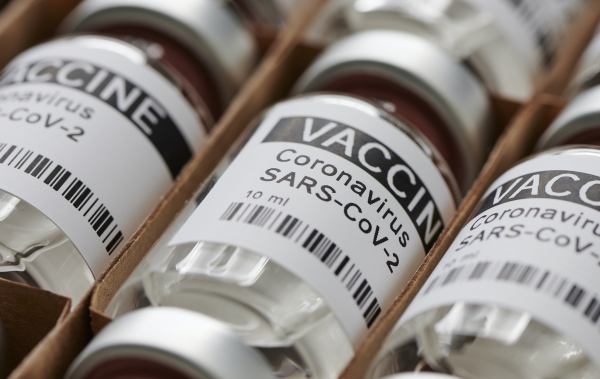The federal government has a 'letter of intent' with AstraZeneca that has no detailed commitment to supply or manufacture any COVID-19 vaccine.
There is a deal with Becton Dickinson for needles and syringes. Clearly, it is the only company currently able to do a detailed deal. If only there was a vaccine to fill these syringes.
The letter of intent with AstraZeneca is an agreement to have an agreement - it is a smart political document that enables the government to give the appearance of acting.
Yet there is no detail - no money and no doses. Why? Because, at this time, AstraZeneca cannot supply this vaccine to Australia and there is no agreement to produce it.
Nor is it a license to manufacture. There is still no commitment from CSL - the only company capable of producing the vaccine in Australia.
The Australian company, which has a contracted commitment to the University of Queensland's investigative vaccine, said it is considering the potential viability of producing the vaccine AstraZeneca is developing with The University of Oxford.
The government is yet to announce any commitment to the global COVAX facility.
The prime minister has also acknowledged the government's own Vaccines and Treatments for Australia – Science and Industry Technical Advisory Group, led by Professor Brendan Murphy, met for the first time this week. The pandemic lockdown was imposed in March. The UK announced the first deal for an investigative COVID-19 vaccine in May.
Australia has a letter of intent while the US, UK, European Union, Japan, India, South Korea, Brazil, China, Indonesia, Argentina and Mexico, all have formal detailed advance supply arrangements or licenses to produce at least one of the investigative COVID-19 vaccines.
The US has agreements covering six of the vaccines, the UK five and Japan three.
Countries started signing agreements with companies and contract manufacturers in May. They have continued to be signed through June, July and early August - governments have now disclosed commitments of something in the vicinity of US$14.5 billion.
The Australian government has so far directly invested $5 million in the development of a vaccine candidate - the vaccine under development as part of a collaboration between the University of Queensland, CSL and the Coalition for Centre Epidemic Preparedness Innovations (CEPI).
It now has a letter of intent to have an agreement.
The relevant Australian-based companies and the wider industry have consistently alerted the federal government - since March - to the realities of the global race for early access to any vaccine.
Yet Australia did not even establish its national COVID-19 vaccine strategy until 7 August - after companies and international non-government organisations had spent the months since May securing over three billion doses of the investigative vaccines.
It seems this global reality has hit home in the past week with the government, including the prime minister, health minister Greg Hunt and senior officials, engaged in an effort to give the appearance of action on a vaccine.
Late last week, Department of Health secretary Professor Brendan Murphy claimed CSL could repurpose one of its facilities in Melbourne in "just a few weeks" to manufacture the AstraZeneca-Oxford adenovirus viral vector vaccine.
Mr Hunt then said the first half of 2021 was the most likely timeframe for a vaccine. Yet when asked about the suggestion the US and UK could be vaccinating people in late 2020, he said Australia would gain access on a "commensurate timeline".
Now the government has a letter of intent that provides no detailed commitment - it appears to be less than what Mexico, Argentina and Indonesia have announced in recent weeks.
The AstraZeneca-Oxford investigative vaccine (AZD1222) is considered one of the leading candidates, certainly in terms of time.
Yet the platform is not as new as some suggest. It has been in development for many years, initially as a vaccine against another coronavirus - Middle East Respiratory Syndrome.
Since the beginning of August, having already secured detailed supply or licensing arrangements for AZD1222 with the US, UK, Japan, South Korea, India, Europe’s Inclusive Vaccines Alliance and the CEPI, the company has announced several new agreements.
On 6 August, it announced Chinese firm BioKangtai will produce at least 100 million doses of AZD1222 by the end of 2020 and expand to 200 million doses per year by the end of 2021.
On 14 August, the company announced two additional deals.
Argentina and Mexico will produce up to 250 million doses of AZD1222 and the European Union announced it has secured 400 million doses of the investigative vaccine - 300 million doses with the option to order another 100 million doses.
Australia has a letter of intent with AstraZeneca that includes 'zero' detail - to the extent the company has not yet disclosed it to shareholders, or even on its twitter feed.
Other companies with a vaccine in development, including Pfizer and its German partner BioNTech, Novavax, Moderna, Novavax and Sanofi with GSK, have also announced detailed agreements.
Novavax even conducted the phase one trial of its vaccine candidate in Australia. In July, the company announced a US$1.6 billion investment by the US 'operation warp speed' to complete late-stage development of the vaccine, including a phase three trial and to establish manufacturing.
It is no surprise Australia has missed out on the Novavax candidate given the national COVID-19 vaccine strategy was only announced 12 days ago - one month after the candidate trialled in Australia was effectively acquired by the US and three months after countries started investing billions to secure an early supply of the leading candidates.
